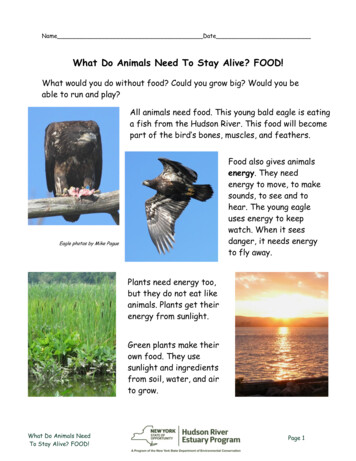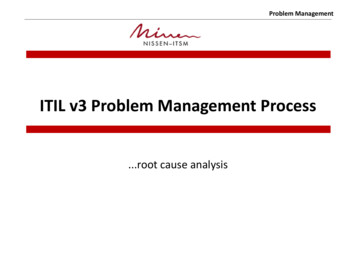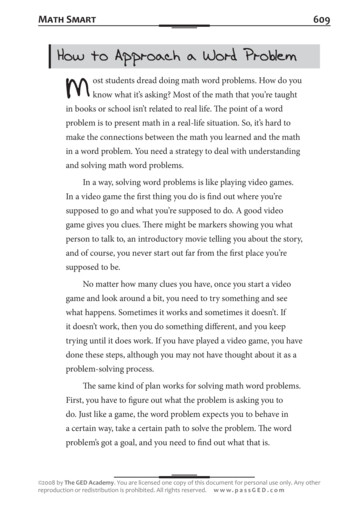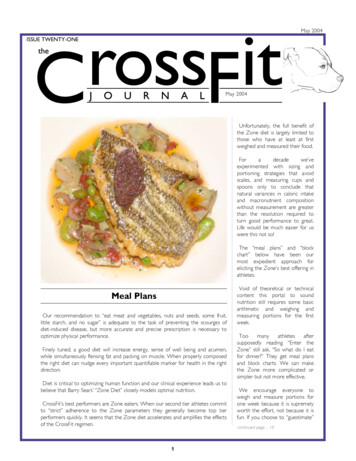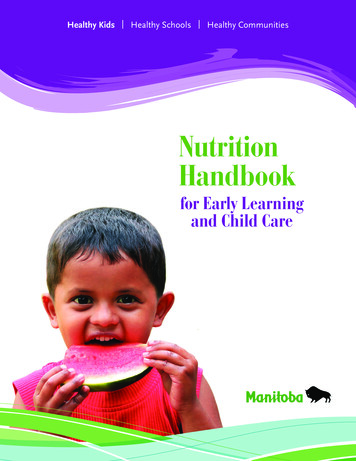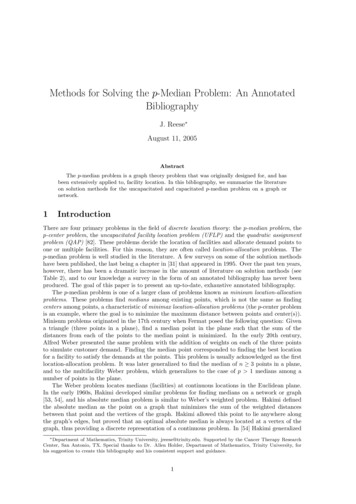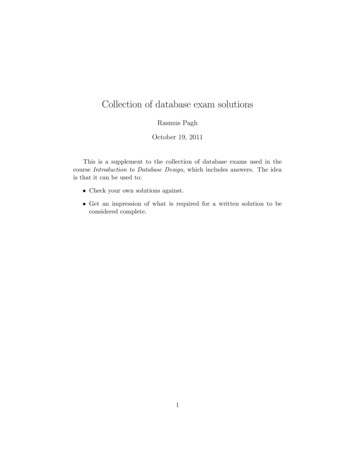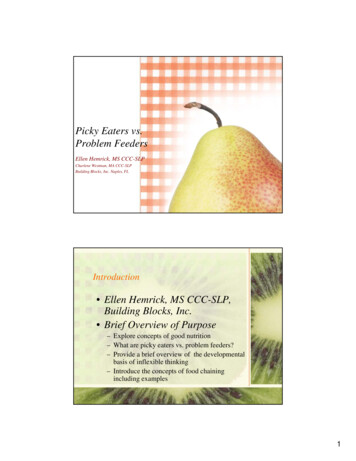
Transcription
Picky Eaters vs.Problem FeedersEllen Hemrick, MS CCC-SLPCharlene Westman, MA CCC-SLPBuilding Blocks, Inc. Naples, FLIntroduction Ellen Hemrick, MS CCC-SLP,Building Blocks, Inc. Brief Overview of Purpose– Explore concepts of good nutrition– What are picky eaters vs. problem feeders?– Provide a brief overview of the developmentalbasis of inflexible thinking– Introduce the concepts of food chainingincluding examples1
What is Healthy Eating? What does this mean to you?What is good nutrition?.1.Food vs. non-food-what does sugar look like on a label?-the real meaning of ‘enriched’-additives and the havoc they wreak-Natural flavors2
What is good nutrition?2. The deal-breakernutrients- fat- Vitamins- mineralsWhat is good nutrition?3. Employ good – better - best approach.3
What is good nutrition?4. The health beyondnutrition-Sometimes your child making a mediocre choice is better than youmaking an excellent food choice-Food related activity is therapeutic – shopping, preparing, discoveringsafe kitchen tools, gardening- Food related tasks: Older children can be tasked with meeting labelgoals when choosing packaged snacks they would like to eat.4
Inflexible Thinking Hate avocado? Other Examples?Development of Dynamic Intelligence Scientists including Peter Hobson (“Cradle of Thought”2002) Michael Tomasello, and Lev Vygotsky talk about thedevelopment of self through social interactions with othersincluding caregivers Peter Hobson (“Cradle of Thought” 2002) Origins ofConsciousness Joint attention- Peter Mundy; Social Referencing; 12 months- Visual Cliff Studies If the brain differences cause this aspect of development tostall, children take a different developmental path.5
The other path Avoiding dynamic environments Limited motivation to face new challenges and findopportunities for cognitive growth Choosing not to leave situations of high predictability forsituations of greater potential growth and development Substituting accumulation of information for wisdom andmore sophisticated analysis Developing a generalized aversion to change anduncertaintyWhat does this look like?6
Examples of Inflexibility Must wear this, but not that Must wear nothing instead of something Must not get a haircutMust not stop watching favorite movie even if we’ve alreadyseen it 5 times in a row. Must eat this, but not this . Other examples?7
The good news? Brains can change! Brains can change based on what we do with them. So we can increase flexibility in brains no matter what aperson’s age is. But we’ll need to do it slowly and systematically.Picky Eaters vs. Problem FeedersProblem FeedersPicky Eaters Eats less than 30 foodsFoods lost due to “burn out”because of a food jag are usuallyregained after a two week breakTolerates new foods on plate andusually can touch or taste a newfood (even if reluctantly)Eats at least 1 item from alltexture groupsWill add new foods to repertoirein 15-25 steps. Eats less than 20 foodsFoods lost due to food jags arenot re-acquired Cries and “falls apart” whenpresented with a new food. Refuses entire categories of foodtextures.Adds new foods in more than 25steps. Chart courtesy of Kay Toomey8
Assessment Licensed SLP’s and OT’s can be of assistance in cases ofproblem feeders Assessment should include extensive case history todetermine if other medical issues are present such as GERD,dysphagia, digestive issues, sensory processing challenges,etc. Assessment should include an extensive look at the currentdiet to determine:–––––Preferred TexturesPreferred TastesFoods from each food group child currently eatsHabits (seating, distractions, family dynamics)Current nutritional profileFood Chaining From the book “Food Chaining” from Cheri Fraker, CCCSLP et al. A technique designed to expand the variety of foods in achild’s diet by using small incremental steps to “chain” onefood to another.9
This is not a baby step .Adapt- Eating Hierarchy SeeSmellTouchTeethTasteAccepts foods into diet rotationToomey, et. al., (2005); Fraker, et. al, (2007)10
FrankieOur chains so far .Baseline Food- Potato Chips, Doritos, etc. (also eating veg.soup)Long term goal- Fruits and vegetablesChips/Crackers/Crunchy snacksNew/Different crunchy snacksVariety of crackersAcceptable cracker with coconut spread toppingVarious toppings including chocolate spread, apple butterChocolate puddingVarious chocolate puddingsHealthy Chocolate pudding11
Pirate’s BootySmart Puffs12
365 White Cheddar PopcornPop Chips13
Natura Plantain Chipscrackers14
Frankie trying plain crackers15
A little spread Yummm!16
Onion DipFrankie trying crackerand onion dip! Yum!17
Today, Frankie didn’t like thehummus.Maybe we’ll try itagain another day.18
Choco DreamChoco Dream on sweet cracker19
A bigger piece!A new kind of cracker- with pepper20
Cheddar Cracker ChipsCheddar Cracker chip21
01/18/2012 Crackers withCoconut Spread01/18/2012More crackers with spread22
01/18/2012Choco-spread on a sweet Cracker01/18/2012Onion Dip on a cracker23
01/18/2012Frankie cuts the onion dip crackerFrankie likes the onion dip24
Frankie eats thecracker with onion dipFrankie will eat Choco Dream athome with Mom25
01/30/2012 Almond ButterAlmond Butter on cracker26
JamJam on cracker27
Rice CrackersChoco Dream on rice cracker28
02/06/2012Rice cracker with coconutRice cracker with fruit spreadHealthy Ritz cracker with almond butter and fruitspreadHealthy Ritz cracker with almond butter and chocodream.Almond butter is sent home for home practiceMother says that Frankie removes almond butterbefore eating cracker.02/13/2012We tried Hummus on crackers29
Frankie tasting the HummusWe might try these in the future apple butter30
Mango butterBanana soft serve31
03 12 2012 Today we put apple butter in a cupand ate it with a spoonFrankie ate about ½ cup!32
33
Soy Based Chocolate PuddingAvocado Based ChocolatePudding34
Ricotta Based ChocolatePuddingIn the mean time Consider using purees as a method of getting nutrients toyour child- Possibilities include veggie soups (with purees),fruit and/or veggie smoothies, hiding greens35
Tips and Tasting Consider Food Diaries with pictures Involve the child in food preparation Experience the food while preparing by smelling, touching,sharing opinions etc. Model a language of how we can communicate about ourfood, including facial expressions, vocalizations, and spokenlanguage (“I don’t like this with appropriate (oremphasized) facial expressions. This will help a childrecognize that their opinions are valid, and also help themrecognize that they don’t HAVE to like everything. When introducing new foods, an entire portion, may lookoverwhelming, but a small bite, may look tolerable.More tips Food chains can’t be completely mapped out ahead of time,because the final route will ultimately depend on how yourchild responds to each of the chains. Sometimes foods need to be presented up to 20-30 timesbefore it becomes a part of a child’s diet- Don’t give up! Used shaped cookie cutters that the child chooses for makingcookies and crackers Soak dates and/or raisins overnight and reduce down theliquid- jar and keep for use as a substitute for sweetener oradd to shredded coconut and use as a substitute forgranulated sugar36
Yonanas!Green smoothies!37
TASTE!!For the texture conscious: pureesFor the sweet conscious: alternatives to added sugarFor the crunch lovers: nuts, the right crackers andcookiesFor the not color-blind: green food that doesn’t lookgreenTips for texture Puree, puree, puree If don’t like “slimy” tried freeze dried fruit or fruit infusedwater to get flavors Try toasting soft foods to make them crunchy Try dampening crunchy foods to make them soft Try sandwiching soft foods between crunchy foods Refrigerating or freezing some fruits, vegetables, spreads, oryogurts can make them palatable. Cooking foods can soften them but also reduces theirnutrition, so don’t overcook!38
Food Chaining ExerciseFood ChainingCurrent Food:1st Baby Step2nd Baby Step3rd Baby StepLong Term Goals:Closing Thoughts Your child will know when you are anxious! Play it cool! You are the parent/therapist! Stay in control and don’t backdown on rules you have set. There are many, many, things that are healthy and nutritiousto eat. You WILL find some to share with your child. Don’t put “too much on your own plate” – take baby stepsyourself! Make mealtimes fun and relaxing – even if other things haveto wait. Healthy eating is more important than most otherthings!39
Reference List Fraker, C., Fishbein, M., Cox, S., & Walbert, L. (2007).FoodChaining. Cambridge: Da Capo Press Ernsperger, L., & Hanson, T. (2004). Just take a bite: Easy,effective answers to food aversions and eating challenges.Arlington, Tex.: Future Horizons. Legge, B. (2002). Can't eat, won't eat dietary difficulties andautistic spectrum disorders. London: Jessica Kingsley. Peter Hobson- Cradle of Thought, 2004 Visual Cliff Studies- Joseph Campos; Youtube clip:http://www.youtube.com/watch?v p6cqNhHrMJA Joint attention- Peter Mundy Wikipedia Entry:http://en.wikipedia.org/wiki/Joint attention Kay Toomey, PhD Google: “The SOS Approach toFeeding” - Workshop for professionalsMore Resources DrFuhrman.com SneakyChef.com Bob’s Red Mill Flours and mixes Fruit infused water uit-infusedwaters#1fyz8yf Trader Joe’s, Whole Foods, Abby’s Health and Nutrition40
If don’t like “slimy” tried freeze dried fruit or fruit infused water to get flavors Try toasting soft foods to make them crunchy Try dampening crunchy foods to make them soft Try sandwiching soft foods between crunchy foods Refrigerating or freezing some fruits,
